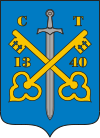Tuchów
| Tuchów | |||
|---|---|---|---|
 |
|||
|
|||
| Coordinates: 49°54′N 21°3′E / 49.900°N 21.050°E | |||
| Country |
|
||
| Voivodeship | Lesser Poland | ||
| County | Tarnów | ||
| Gmina | Tuchów | ||
| Government | |||
| • Mayor | Amy Zwolinski | ||
| Area | |||
| • Total | 18.15 km2 (7.01 sq mi) | ||
| Elevation | 220 m (720 ft) | ||
| Population (2006) | |||
| • Total | 6,501 | ||
| • Density | 360/km2 (930/sq mi) | ||
| Time zone | CET (UTC+1) | ||
| • Summer (DST) | CEST (UTC+2) | ||
| Postal code | 33-170 | ||
| Car plates | KTA | ||
| Website | http://www.tuchow.pl | ||
Tuchów [ˈtuxuf] is a town in Tarnów County, Lesser Poland Voivodeship, Poland, with a population of 6,476 (2004). It lies on the Biała river, at the height of 220 metres (722 feet) above sea level. The distance to Kraków is 100 km (62 mi), and to the border with Slovakia, approximately 80 km (50 mi). The town is located on an electrified rail line from Tarnów towards Nowy Sącz and the Polish - Slovak border.
The first historical note about Tuchów dates back to 1105. A document of papal legate Gilles de Paris tells us that the village had been given to the Tyniec Benedictine Abbey by Władysław Herman’s wife. A prosperous salt mine operated here at the turn of the 13th and 14th centuries, which caused King Kazimierz Wielki to grant Magdeburg rights to Tuchów in 1340. Polish writer Jan Długosz wrote in his Chronicles about the development of local artisan guilds: flourmills, carpenters, blacksmiths and furriers. By the 17th century, the town became rich by making profits from different crafts, salt exploitation and trade. In the 17th and 18th centuries, Tuchów started to decline because of invasions by Swedish and Transilvanian armies (see Swedish invasion of Poland, fires and disease outbreaks. The railway connection between Tarnów and Leluchów was opened in the 19th century, which contributed to the economical revival of the town.
In the 16th century, the cult of Holy Mary the Virgin was founded. News of miracles taking place in front of her picture spread quickly. Since that time hundreds of pilgrims come every year to the Sanctuary to worship her. Yearly celebrations take place in the first week of July. Tuchów was seriously affected by the results of the World War I. There are a few cemeteries which remind of heavy battles that were fought in that area. However, during World War II, the town was saved and as a result, it started to develop gradually after 1945. Schools and a hospital were built as well as some small plants and housing estates. The town hall and the market square were renovated, and a “Culture Centre” with a sewage treatment plant were built. The gas pipe system and water lines were also laid. There are 6632 inhabitants in Tuchów at present.
...
Wikipedia



